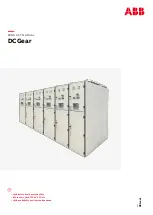
the direction from the right to the left, and exits the lens on the opposite side. When the
complex impedance exits the lens on the side opposite to its entrance, the 1st pole-slip
has already occurred and more pole-slips can be expected if the generator is not
disconnected.
shows two pole-slips. Figures like
are always possible to draw by means of the analog output data from the pole-slip
function, and are of great help with eventual investigations of the performance of the
out-of-step function.
7.6.7.3
Maximum slip frequency
A pole-slip may be detected if it has a slip frequency lower than a maximum value
fsMax
. The specific value of
fsMax
depends on the setting (parameter)
StartAngle
(which determines the width of the lens characteristic). A parameter in this calculation
routine is the value of the minimum traverse time,
traverseTimeMin
. The minimum
traverse time is the minimum time that the travel of the complex impedance Z(R, X)
through the lens, from one side to the other, must last in order to recognize that a pole-
slip has occurred. The value of the internal constant
traverseTimeMin
is a function of
the set
StartAngle
.For values of
StartAngle
<= 110°,
traverseTimeMin
= 50 ms. For
values
StartAngle
> 110°,
traverseTimeMin
= 40 ms. The expression which relates the
maximum slip frequency
fsMax
and the
traverseTimeMin
is as follows:
fsMax Hz
traverseTimeMin ms
StartAngle
[
]
≅
[
]
⋅
°
[ ]
°
[
1000
1 000
180
.
-
]]
IECEQUATION2319 V1 EN
(Equation 48)
The maximum slip frequency
fsMax
for
traverseTimeMin
= 50 ms is:
StartAngle = 90° → fsMax = 20 × 0.500 = 10.000 Hz
StartAngle = 100° → fsMax = 20 × 0.444 = 8.888 Hz
StartAngle = 110° → fsMax = 20 × 0.388 = 7.777 Hz
(default 110°)
The maximum slip frequency
fsMax
for
traverseTimeMin
= 40 ms is:
StartAngle = 120° → fsMax = 25 × 0.333 = 8.333 Hz
StartAngle = 130° → fsMax = 25 × 0.277 = 6.944 Hz
The minimum value of
fsMax
is 6.994 Hz. When
StartAngle
= 110 degrees,
fsMax
=
7.777 Hz. This implies, that the default
StartAngle
= 110 degrees covers 90% of cases
as, the typical final slip frequency is between 2 - 5Hz. In practice, however, before the
slip frequency, for example 7.777 Hz, is reached, at least three pole-slips have
occurred. In other words, if we consider a linear increase of frequency from 50 Hz to
57.777 Hz, at least three pole-slips will occur (in fact: (57.777 - 50) / 2 = 3.889). The
exact instantaneous slip-frequency expressed in Hz (corresponding to number of pole
slips per second) is difficult to calculate. The easiest and most exact method is to
measure time between two successive pole slips. This means that, the instantaneous
slip-frequency is measured only after the second pole-slip, if the protected machine is
Section 7
1MRK502052-UEN B
Impedance protection
268
Technical manual
Summary of Contents for Relion REG670
Page 1: ...Relion 670 series Generator protection REG670 2 0 IEC Technical manual ...
Page 2: ......
Page 44: ...38 ...
Page 58: ...52 ...
Page 80: ...74 ...
Page 106: ...100 ...
Page 482: ...476 ...
Page 548: ...542 ...
Page 570: ...564 ...
Page 600: ...594 ...
Page 608: ...602 ...
Page 630: ...624 ...
Page 862: ...856 ...
Page 1094: ...1088 ...
Page 1226: ...1220 ...
Page 1250: ...1244 ...
Page 1297: ...1291 ...
















































